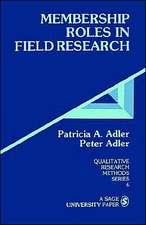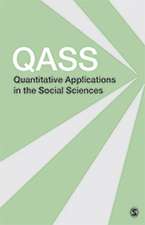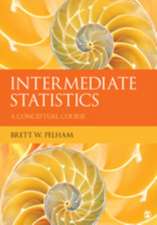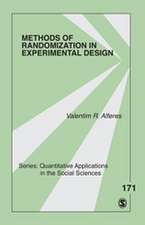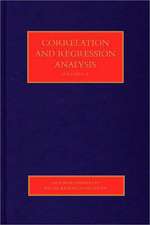A Guide to Qualitative Field Research
Autor Carol R. Baileyen Limba Engleză Paperback – 5 feb 2018
Preț: 536.83 lei
Preț vechi: 725.45 lei
-26% Nou
Puncte Express: 805
Preț estimativ în valută:
102.73€ • 111.55$ • 86.30£
102.73€ • 111.55$ • 86.30£
Carte disponibilă
Livrare economică 02-16 aprilie
Livrare express 18-22 martie pentru 29.33 lei
Preluare comenzi: 021 569.72.76
Specificații
ISBN-13: 9781506306995
ISBN-10: 1506306993
Pagini: 280
Dimensiuni: 187 x 232 x 18 mm
Greutate: 0.48 kg
Ediția:Third Edition
Editura: SAGE Publications
Colecția Sage Publications, Inc
Locul publicării:Thousand Oaks, United States
ISBN-10: 1506306993
Pagini: 280
Dimensiuni: 187 x 232 x 18 mm
Greutate: 0.48 kg
Ediția:Third Edition
Editura: SAGE Publications
Colecția Sage Publications, Inc
Locul publicării:Thousand Oaks, United States
Recenzii
“Methods texts often suffer from dry material and inaccessible definitions. This text makes methods accessible through an inviting, jargon-free tone, and engaging through its many creative suggestions for applying the lessons in hands-on exercises.”
“This book offers a very comprehensive examination of fieldwork that includes practical and theoretical guidance for all students–undergraduate and graduate. The inclusion of online participant-observation considerations sets this book apart from all the others.”
“So much more than most methods texts, this text actually offers the tools and examples to help students actually plan and do research. Full of practical examples, useful tips, frameworks and tactics, this text is a great primer for students who want to get out into the field”
“A Guide to Qualitative Research is an invaluable handbook for students embarking on qualitative research. Comprehensive, detailed, and engaging, it covers all of the key elements of qualitative research and is an insightful and practical text to inspire and guide future qualitative researchers.”
“Carol Bailey’s work is of the highest quality. I wholeheartedly consider it to be one of the better qualitative fieldwork texts geared toward neophyte students of qualitative research that I have come across in many years. It is obvious that she put some time into thinking about and conceptually organizing the book. It all flows together quite nicely with an engaging and crisp writing style that will keep readers attention.”
“A Guide to Qualitative Field Research is an accessible introduction to the design and conduct of qualitative research. For students new to this methodology, this text provides insight into key concepts and issues that should be part of their methodological toolkit, so that they know how to begin their studies, what to expect along the way, and strategies to address those “bumps” that are all too common in field research.”
“This book offers a very comprehensive examination of fieldwork that includes practical and theoretical guidance for all students–undergraduate and graduate. The inclusion of online participant-observation considerations sets this book apart from all the others.”
“So much more than most methods texts, this text actually offers the tools and examples to help students actually plan and do research. Full of practical examples, useful tips, frameworks and tactics, this text is a great primer for students who want to get out into the field”
“A Guide to Qualitative Research is an invaluable handbook for students embarking on qualitative research. Comprehensive, detailed, and engaging, it covers all of the key elements of qualitative research and is an insightful and practical text to inspire and guide future qualitative researchers.”
“Carol Bailey’s work is of the highest quality. I wholeheartedly consider it to be one of the better qualitative fieldwork texts geared toward neophyte students of qualitative research that I have come across in many years. It is obvious that she put some time into thinking about and conceptually organizing the book. It all flows together quite nicely with an engaging and crisp writing style that will keep readers attention.”
“A Guide to Qualitative Field Research is an accessible introduction to the design and conduct of qualitative research. For students new to this methodology, this text provides insight into key concepts and issues that should be part of their methodological toolkit, so that they know how to begin their studies, what to expect along the way, and strategies to address those “bumps” that are all too common in field research.”
Cuprins
List of Tables, Figures, and Photographs
Preface
Acknowledgments
About the Author
Chapter 1. Introduction to Qualitative Field Research
Objectives
Overview
Examples of Field Research
Major Features of Field Research
Putting It All Together
Conclusions
Chapter Highlights
Exercises
Online and Recommended Reading
Chapter 2. Ethics
Objectives
Informed Consent
Deception
Confidentiality
Relationships
Ethics in Virtual Field Research
Conclusions
Chapter Highlights
Exercises
Online and Recommended Reading
Chapter 3. Topic, Purpose, and Research Questions
Objectives
Research Topic
Purpose of Research
Research Questions
Putting It All Together
Conclusions
Chapter Highlights
Exercises
Online and Recommended Reading
Chapter 4. Theory and Review of Literature
Objectives
Concepts
Theory
Review of Literature
Putting It All Together
Conclusions
Chapter Highlights
Exercises
Online and Recommended Reading
Chapter 5. Paradigms, Research Design, and Introduction to Methodology
Objectives
Proposal
Paradigms
Research Design
Methodology
Conclusions
Chapter Highlights
Exercises
Online and Recommended Reading
Chapter 6. From Gaining Entrée to Exiting the Field
Objectives
Gaining Entrée and Gatekeepers
Preparations
Arrival in the Field
Key Actors
Field Relationships
Time in the Field
Leaving the Field
Conclusions
Chapter Highlights
Exercises
Online and Recommended Reading
Chapter 7. Observations
Objectives
Should I Conduct Covert or Overt Observations?
Should I Only Observe or Participate Fully When Observing?
Where Should I Observe?
Should My Observations Be Structured or Unstructured?
What Should I Observe?
Research Questions
Unit of Analysis
Ethics
Conclusions
Chapter Highlights
Exercises
Online and Recommended Reading
Chapter 8. Interviews
Objectives
Types of Interviews
Question Construction
Interview Questions and Research Questions
Location of the Interview
Rapport
Ethics
Status Characteristics
Alternatives to Face-to-Face Interviews
After the Interview
Sampling
Conclusions
Chapter Highlights
Exercises
Online and Recommended Reading
Chapter 9. Field Notes
Objectives
Purposes of Field Notes
Taking Field Notes
Field Note Content
Putting It All Together
Conclusions
Chapter Highlights
Exercises
Online and Recommend Reading
Chapter 10. Procedures for Increasing Validity and Trustworthiness
Objectives
Validity and Trustworthiness
Strategies for Enhancing Validity and Trustworthiness
Conclusions
Chapter Highlights
Exercises
Online and Recommended Reading
Chapter 11. Introduction to Analysis and Coding
Objectives
Analysis
Coding
Practical Aspects of Coding
Coding and Grounded Theory
Computer-Assisted Qualitative Data Analysis Software
Putting It All Together
Conclusions
Chapter Highlights
Exercises
Online and Recommended Reading
Chapter 12. Descriptions and Typologies
Objectives
Descriptions
Typologies
Conclusions
Chapter Highlights
Exercises
Online and Recommended Reading
Chapter 13. Thematic Analysis
Objectives
Purposes of a Thematic Analysis
What Are Themes?
Identifying Versus Emerging Themes
Overarching Themes
Topical Themes
Interpretation
Conclusions
Chapter Highlights
Exercises
Online and Recommended Reading
Chapter 14. Research Stories and Critical Events and Cases
Objectives
Elements in a Research Story
Critical Events and Cases
Conclusions
Chapter Highlights
Exercises
Online and Recommend Reading
Chapter 15. Writing and the Final Paper
Objectives
Writing Process
Writing Styles Used in Final Papers
Format of a Final Paper
Putting It All Together
Conclusions
Chapter Highlights
Exercises
Online and Recommended Reading
References
Glossary
Index
Preface
Acknowledgments
About the Author
Chapter 1. Introduction to Qualitative Field Research
Objectives
Overview
Examples of Field Research
Major Features of Field Research
Putting It All Together
Conclusions
Chapter Highlights
Exercises
Online and Recommended Reading
Chapter 2. Ethics
Objectives
Informed Consent
Deception
Confidentiality
Relationships
Ethics in Virtual Field Research
Conclusions
Chapter Highlights
Exercises
Online and Recommended Reading
Chapter 3. Topic, Purpose, and Research Questions
Objectives
Research Topic
Purpose of Research
Research Questions
Putting It All Together
Conclusions
Chapter Highlights
Exercises
Online and Recommended Reading
Chapter 4. Theory and Review of Literature
Objectives
Concepts
Theory
Review of Literature
Putting It All Together
Conclusions
Chapter Highlights
Exercises
Online and Recommended Reading
Chapter 5. Paradigms, Research Design, and Introduction to Methodology
Objectives
Proposal
Paradigms
Research Design
Methodology
Conclusions
Chapter Highlights
Exercises
Online and Recommended Reading
Chapter 6. From Gaining Entrée to Exiting the Field
Objectives
Gaining Entrée and Gatekeepers
Preparations
Arrival in the Field
Key Actors
Field Relationships
Time in the Field
Leaving the Field
Conclusions
Chapter Highlights
Exercises
Online and Recommended Reading
Chapter 7. Observations
Objectives
Should I Conduct Covert or Overt Observations?
Should I Only Observe or Participate Fully When Observing?
Where Should I Observe?
Should My Observations Be Structured or Unstructured?
What Should I Observe?
Research Questions
Unit of Analysis
Ethics
Conclusions
Chapter Highlights
Exercises
Online and Recommended Reading
Chapter 8. Interviews
Objectives
Types of Interviews
Question Construction
Interview Questions and Research Questions
Location of the Interview
Rapport
Ethics
Status Characteristics
Alternatives to Face-to-Face Interviews
After the Interview
Sampling
Conclusions
Chapter Highlights
Exercises
Online and Recommended Reading
Chapter 9. Field Notes
Objectives
Purposes of Field Notes
Taking Field Notes
Field Note Content
Putting It All Together
Conclusions
Chapter Highlights
Exercises
Online and Recommend Reading
Chapter 10. Procedures for Increasing Validity and Trustworthiness
Objectives
Validity and Trustworthiness
Strategies for Enhancing Validity and Trustworthiness
Conclusions
Chapter Highlights
Exercises
Online and Recommended Reading
Chapter 11. Introduction to Analysis and Coding
Objectives
Analysis
Coding
Practical Aspects of Coding
Coding and Grounded Theory
Computer-Assisted Qualitative Data Analysis Software
Putting It All Together
Conclusions
Chapter Highlights
Exercises
Online and Recommended Reading
Chapter 12. Descriptions and Typologies
Objectives
Descriptions
Typologies
Conclusions
Chapter Highlights
Exercises
Online and Recommended Reading
Chapter 13. Thematic Analysis
Objectives
Purposes of a Thematic Analysis
What Are Themes?
Identifying Versus Emerging Themes
Overarching Themes
Topical Themes
Interpretation
Conclusions
Chapter Highlights
Exercises
Online and Recommended Reading
Chapter 14. Research Stories and Critical Events and Cases
Objectives
Elements in a Research Story
Critical Events and Cases
Conclusions
Chapter Highlights
Exercises
Online and Recommend Reading
Chapter 15. Writing and the Final Paper
Objectives
Writing Process
Writing Styles Used in Final Papers
Format of a Final Paper
Putting It All Together
Conclusions
Chapter Highlights
Exercises
Online and Recommended Reading
References
Glossary
Index
Notă biografică
Carol A. Bailey is an associate professor emerita of sociology at Virginia Tech. She has won numerous teaching awards at the department and university level, including the Alumni Award for Teaching Excellence and the Wine Award for Excellence in Teaching. She taught undergraduate research methods and graduate-level courses on qualitative methodology and pedagogy. Once the Director of the University Writing Program, her research focused on evaluating programs that promote science education and those that serve children with severe mental illnesses and their families.
Descriere
A Guide to Qualitative Field Research provides readers with clear, practical, and specific instructions for conducting qualitative research in the field. In the expanded Third Edition, Carol A. Bailey gives increased attention to the early and last stages of field research, often the most difficult: selecting a topic, deciding upon the purpose of your research, and writing the final paper, all in her signature reader-friendly writing style.




